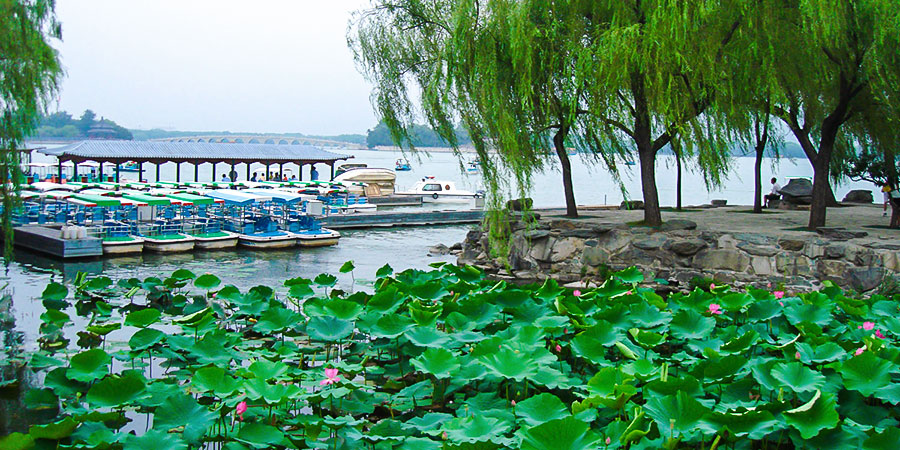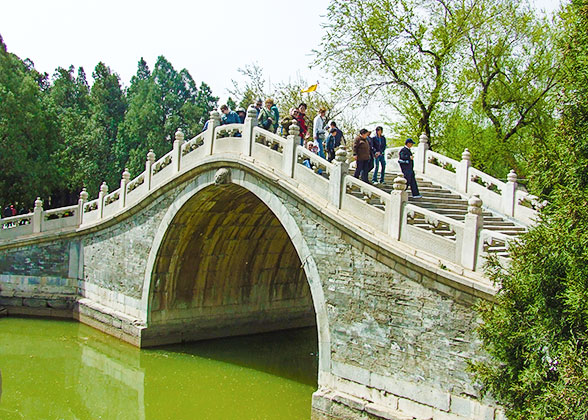West Causeway (Xidi)
Kunming Lake is the largest body of water in the Qing Dynasty Imperial Gardens. The long West Causeway stretches from the northwest to the south of the Summer Palace. It divides the lake into three discreet areas each with its own island in the center. They are intended to resemble the legendary 'three fairy islands (Penglai, Yingzhou and Fangzhang) in the East China Sea.' The West Causeway (or Bank) was modeled after the Sudi (or Su Causeway) in West Lake, Hangzhou during the reign of Emperor Qianlong.
The West Causeway was created to perfectly adorn the man-made lake area it embraced. In spring it is a long path of riotous floral profusion with new buds sprouting on the willows and bracts on the peach trees. The causeway is connected by six bridges each unique in style: Jiehu (Lake-Boundary) Bridge; Bridge of Binfeng (Pastoral Poems); Jade-Belt Bridge; Mirror (Jing) Bridge; Lian (White-Silk) Bridge and Willow (Liu) Bridge. They combine to recreate the scenery of South China. Its picturesque setting, at once tranquil and elegant, makes it a popular retreat.
The Farming and Weaving Scenic Area was originally built in 1750 during the reign of Emperor Qianlong. Networks of rivers and lakes replete with paddies also recreate the South China scenery at that time. However, the area burned down during the war in 1860. Only a monument inscribed by Emperor Qianlong has survived to the present day. The Culture Exhibition of Farming and Weaving Scenic Area was re-opened to the public in 2004 following major renovations.
Walk along the lake bank beside the Farming and Weaving Scenic Area till you reach Jiehu Bridge, the boundary between the Front and Back Lake. It was originally called the Willow Bridge and the present Willow Bridge at the south end of the West Causeway was called Lake Boundary Bridge. Their names were exchanged when the Summer Palace was ordered rebuilt by Empress Dowager Cixi.
Binfeng Bridge, with a square kiosk above was built in the style of bridges in South China. It was named Sangzhu (Mulberry Ramie) Bridge by Emperor Qianlong. The character 'zhu' sounds like the name of Emperor Xianfeng (named Yi Zhu) and 'sangzhu' sounds like the words for 'chief mourner'. It was later changed to its present name, 'Bing feng. 'Bingfeng is a word from the first poetry collection in China, the Classic of Odes and it means 'farming atmosphere.'
Jade-Belt Bridge, the most renowned and beautiful of the six bridges, is made of white and black marble. It is the only one of the bridges with arches. Its fluid contour lines are woven graciously together, hence its name. Seen from afar, it resembles a jade belt. Its high arch enables Emperor Qianlong's boat to pass through on his way to Jade Spring Mountain to the west of the Summer Palace.
Mirror Bridge gained its name from the artistic verse of the noted poet Li Bai (701 - 762) in the Tang Dynasty--'two waters frame an unblemished mirror; twin bridges form a rainbow.' There is a square opening and an octagonal kiosk over the bridge.
Lian Bridge and Willow Bridge got their names from famous poems. They were destroyed by the Anglo-French Allied Forces in 1860 along with the Pavilion of Bright Scenery located between the two bridges. The pavilion's name was derived from "The spring is peaceful and the scenery bright, a phrase in the famous essay describing the Yueyang Tower by Fan Zhongyan (a well-known writer in the Song Dynasty). While the two bridges were rebuilt during Emperor Guangxu's reign in the late 1800's, the pavilion wasn't rebuilt until 1991.
The sub-causeway between Jade Belt Bridge and Mirror Bridge leads to the West Gate of the Summer Palace. To the north of the sub-causeway, the Governing Mirror Tower lies on the small island in the middle of the lake area. The Hall of Good Sight is located west of the West Gate. There is a paved pathway nearby and the Hall of Recognition of Talent is located at the end of it. They are the other two 'fairy islands' other than the Nanhu Island.
The West Causeway was created to perfectly adorn the man-made lake area it embraced. In spring it is a long path of riotous floral profusion with new buds sprouting on the willows and bracts on the peach trees. The causeway is connected by six bridges each unique in style: Jiehu (Lake-Boundary) Bridge; Bridge of Binfeng (Pastoral Poems); Jade-Belt Bridge; Mirror (Jing) Bridge; Lian (White-Silk) Bridge and Willow (Liu) Bridge. They combine to recreate the scenery of South China. Its picturesque setting, at once tranquil and elegant, makes it a popular retreat.
 |
| Lotus in the Kunming Lake |
The Farming and Weaving Scenic Area was originally built in 1750 during the reign of Emperor Qianlong. Networks of rivers and lakes replete with paddies also recreate the South China scenery at that time. However, the area burned down during the war in 1860. Only a monument inscribed by Emperor Qianlong has survived to the present day. The Culture Exhibition of Farming and Weaving Scenic Area was re-opened to the public in 2004 following major renovations.
Walk along the lake bank beside the Farming and Weaving Scenic Area till you reach Jiehu Bridge, the boundary between the Front and Back Lake. It was originally called the Willow Bridge and the present Willow Bridge at the south end of the West Causeway was called Lake Boundary Bridge. Their names were exchanged when the Summer Palace was ordered rebuilt by Empress Dowager Cixi.
Binfeng Bridge, with a square kiosk above was built in the style of bridges in South China. It was named Sangzhu (Mulberry Ramie) Bridge by Emperor Qianlong. The character 'zhu' sounds like the name of Emperor Xianfeng (named Yi Zhu) and 'sangzhu' sounds like the words for 'chief mourner'. It was later changed to its present name, 'Bing feng. 'Bingfeng is a word from the first poetry collection in China, the Classic of Odes and it means 'farming atmosphere.'
 |
| Jade-belt Bridge |
Mirror Bridge gained its name from the artistic verse of the noted poet Li Bai (701 - 762) in the Tang Dynasty--'two waters frame an unblemished mirror; twin bridges form a rainbow.' There is a square opening and an octagonal kiosk over the bridge.
Lian Bridge and Willow Bridge got their names from famous poems. They were destroyed by the Anglo-French Allied Forces in 1860 along with the Pavilion of Bright Scenery located between the two bridges. The pavilion's name was derived from "The spring is peaceful and the scenery bright, a phrase in the famous essay describing the Yueyang Tower by Fan Zhongyan (a well-known writer in the Song Dynasty). While the two bridges were rebuilt during Emperor Guangxu's reign in the late 1800's, the pavilion wasn't rebuilt until 1991.
The sub-causeway between Jade Belt Bridge and Mirror Bridge leads to the West Gate of the Summer Palace. To the north of the sub-causeway, the Governing Mirror Tower lies on the small island in the middle of the lake area. The Hall of Good Sight is located west of the West Gate. There is a paved pathway nearby and the Hall of Recognition of Talent is located at the end of it. They are the other two 'fairy islands' other than the Nanhu Island.
![]() Next: East Causeway
Next: East Causeway
![]() Related Link: Summer Palace Travel Tips
Related Link: Summer Palace Travel Tips
- Last updated on Aug. 16, 2024 by Gabby Li -